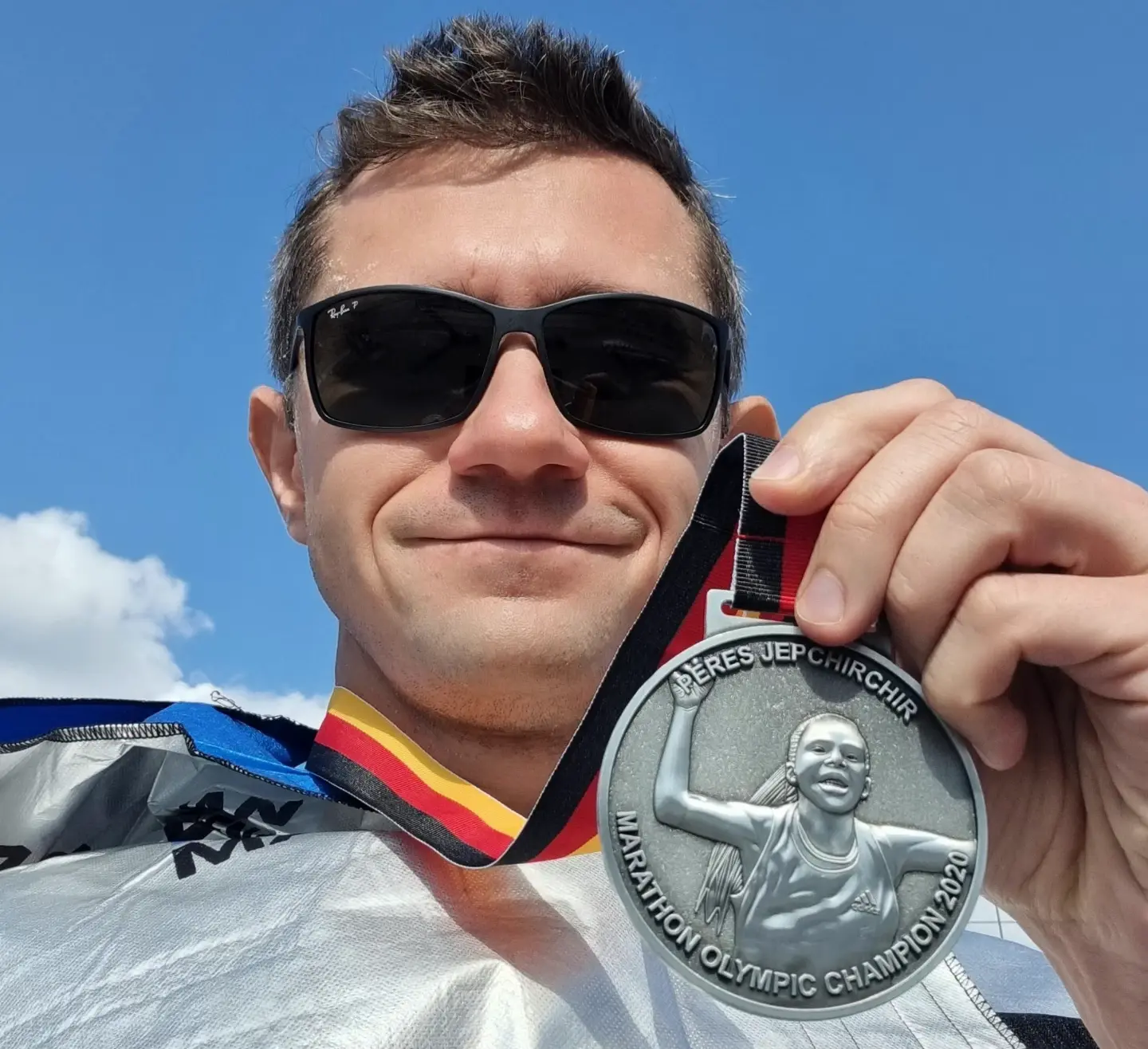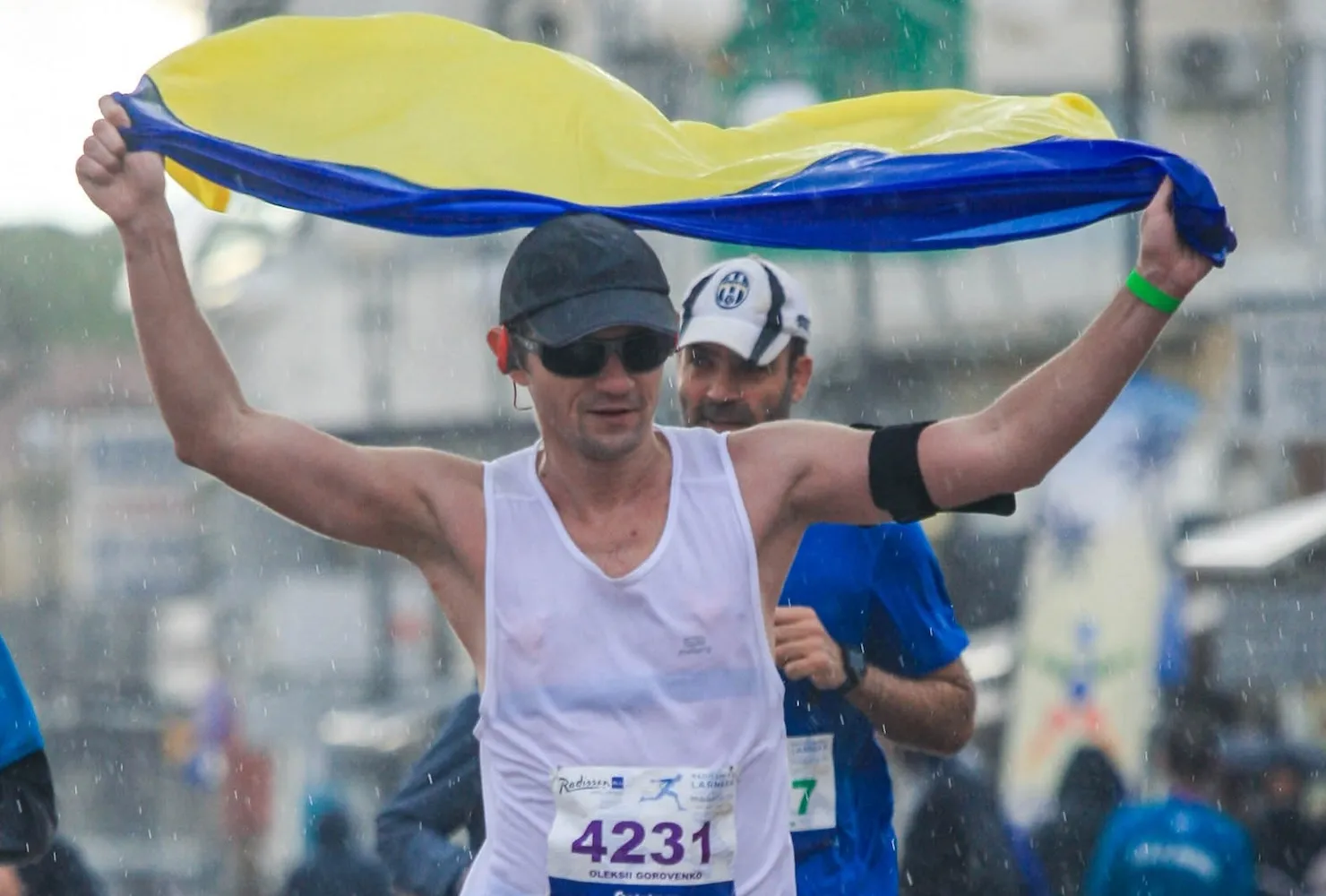Last year, I applied to the Berlin Marathon and won the lottery. After running the course and improving my PB by 26 minutes (more on that later), I'll share my experience. So you'll be better prepared for your race.
7 Quick Facts about the Berlin Marathon
- 47,912 participants (2023)
- 13 times world records have been broken here
- It's a Gold-label IAAF race, included in the World Marathon Majors
- Course Record Men: Eliud Kipchoge 2:01:09 (2022)
- Course Record Women: Tigst Assefa 2:11:53 (2023)
- Participation fee: 205€ ($225) — relatively expensive for Europe
- Usual date: the last Sunday of September
First things first, How do you enter the Berlin Marathon?
Lottery. Like most runners, I got admission by winning the lottery. The chance of winning is about 5-15%, but it varies. The lottery usually opens one week after the race and lasts 45 days. The results will be announced by the end of December.
Qualifying time. Fast runners can secure the spot with the following qualifying times:
- Men: <2:45 hours
- Women: < 3:10 hours
Yes, the time qualifier is tough in Berlin.
Skate to run. The unique alternative way to get to the start line is the "skate to run" event. So, if you participated in last year's inline skating event (which takes place one day before the marathon), you get admission to run the following year's race.
Others. Different ways to get to the Berlin Marathon include tour operators and charities (~1,000€/$1,100 or more).
The Expo
The Berlin Marathon Expo is held at the Flughafen Templehof, an old non-operating airport terminal. It is divided into indoor and outdoor sections, resembling an active airport. As I stepped inside, I felt like I should be boarding a plane or waiting for my luggage.
The Expo covered all the typical features of a big marathon race event, including many vendors, official merchandise outlets, and an extensive Adidas store, the official brand for the Berlin Marathon.
Crucial items to bring with you to the Expo include:
- your start card (which is emailed to you 14 days before the race)
- your government ID with a photo, which must match the information provided in the registration.
The three essential items you'll receive at the Expo are:
- wristband
- race bib
- tracking chip
You, and only you personally, can pick up the starting kit. They use hot wax to fix the wristband to your wrist, and it cannot be removed without cutting it. This wristband is your pass to the start area.
Unlike typical race bibs, Berlin's bibs are printed instantly on the counter and lack a timing chip. On the Berlin Marathon, the timing chip goes separately and looks like a small plastic thing that attaches to your shoe. It's easy to forget about it and leave it at home.
On the Berlin Marathon, you can choose between two options: either a poncho after the finish or a bag drop before the race—you can't take both and need to decide in advance. If you're checking items on race day, don't forget to pick up the official bag with your number.
The one detail to be aware of is the long lines, mainly for bib pickup. The lines usually move fast, but be prepared to spend time there. If you're coming straight from the airport and need to store bags, note that there's a fee for large luggage.
The timing of your visit to the Expo is vital. Thursday or Friday is the best time for shopping, as items tend to sell out quickly. Saturday can be extremely crowded, especially around noon. So, get to the Expo as early as you can.
The hosts don't allow you to change your starting corral on the Expo. The latest you can change it is one week before the race online (for a target time of 3:15 or faster, you'll need proof).
The Breakfast Run and Bambini Race
The hosts organize a free 5K shakeout run on Saturday before the marathon. I usually don't run a day before the race, so I didn't participate. However, everybody is welcome to run, and it's a lot of fun.
On the same day, there is a Bambini race for children at the Expo. It's a very short 200-1,000 meters race for children. If you're traveling with a family, I recommend participating.
The Starting Area Map and Timeline
The start and finish are in the same place. Bookmark the Reichstag Building on Google Maps — the single entrance to the starting area is in front of it.
The race starts with hand biker Elites at 8:50 AM, followed by wheelchairs and non-elite hand bikers at 9:57 AM. The runners are divided into four waves:
| Start Time | Wave | Corrals | Target Time |
|---|---|---|---|
| 9:15 | 1st | A, B, C, D | 3:00-3:30 |
| 9:40 | 2nd | E, F | 3:00-3:45 |
| 10:05 | 3rd | G, H | 3:30-4:15 |
| 10:30 | 4th | J, K | 4:15+ |
I recommend arriving at the Reichstag at least 1.5 hours before the start of your wave. Some areas have lines and bottle-necks so getting to your corral 5 minutes before the start would be challenging.
The start and finish area is securely enclosed with a tall fence, allowing only runners to enter. Friends and supporters won't be able to join you. Wristbands and bib numbers are checked at the entrance.
If you've chosen bag drop, three drop-off locations are far from the corrals. So, take old clothes or a garbage bag to keep warm and toss them before the start. The start area is crowded. Expect to wait for a while, but there's music, dancing, and songs to keep you entertained.
If you're running for time and want to perform well in a race with 45,000+ participants, it's worth getting there early and positioning yourself ahead. The course is crowded, but it spreads out eventually.
Pacing and Pacers
Pacing can be challenging at the Berlin Marathon if you are used to miles, as the course doesn't have mile markers, only kilometers. Having a pacing plan in advance is vital to avoid complex calculations during the race.
The pacers are available for every wave:
- In wave 1, you'll find 3:00, 3:15, and 3:30 pacers.
- Wave 2 includes pacers for 3:15, 3:30, and 3:45.
- Wave 3 has pacers for 3:30, 3:45, and 4:15
- Wave 4 contains pacers for 4:15, 4:30, 4:45, and 5.
These pacemakers are easily recognizable, carrying giant flags and moving in pairs.
Because the race is crowded, pacers usually get a lot of people around, making running more challenging and less enjoyable. Consider moving in front of your pacers or somewhere in the back of the crowd to have more space and fresh air.
Berlin Marathon Course
Elevation. The course is flat – my Garmin watch tracked only 62 m/203 feet of elevation gain. There are no hills worth mentioning; the elevation spreads more or less evenly throughout the course.
Sun exposure. You start relatively early in the morning when the sun isn't active yet. Moreover, it's cloudy in Berlin this time of the year. In the second half of the race, you'll run mostly in the shadow — it's unusual but fortunate.
Turns. There are 55 turns throughout the race. The frequent turns can impact your race time and affect the accuracy of your watch. Running the tangents is a recommended strategy, even though it's unrealistic with so many participants—you'll never run alone.
The Shortest Route. Another course feature is the three blue lines that run the entire course and represent the shortest certified distance for a marathon, measuring 42.195 meters. So, stick to the blue lines, but respect other runners around.
Aid stations. They're approximately every 2-3K (1.5-2 miles). A few first stations offer only water, while those later in the race provide fruits, cold tea, and Maurten Drink Mix 160. Also, one aid station at 27.5K provides Maurten Gel 100.
Some aid stations are only located on one side of the street, with just a few tables.
The aid stations use plastic cups with thick sides for water. The plastic cups are challenging to drink from while running, as you can't create a small opening by squeezing the top. Also, they become incredibly slippery on the ground.
An option to consider is bringing your own labeled bottle with your hydration to the Expo, which can be placed at the front table of the aid stations on a race day. Everybody can order the service at the Berlin marathon at no extra cost. However, ensure you clearly label your bottles.
Lastly, carrying your own hydration system, like a vest, back, or belt, is allowed.
Finish
One notable landmark you'll encounter close to the end of the race is the Brandenburg Gate. It's an iconic spot, and many runners confuse it with the finish line. Remember that you'll still have about 400-500 meters to go before you finish the race.
The Poncho is a lightweight but excellent souvenir with the event logo and a hood. It isn't thick, but it's practical for returning to your hotel if you've chosen this option.
If you opted for the bag check, here's a unique feature – showers and changing tents are available at the finish line. It's not something you typically find in other marathons, but it allows you to freshen up and celebrate after the race.
The Finish Line Festival offers massages and medal engraving. Remember to order the services upfront or bring cash, as sometimes they do not accept cards.
When leaving the finish area, ensure you drop the timing chip in one of the buckets provided at the exits. If you accidentally leave without returning the chip, there's a fee, so it's best to avoid this hassle and get it done.
Regarding the timing chip placement, securing it near the top of your shoe is a good idea. After running 26.2 miles, you'll find it challenging to bend down and undo your laces.
Where to stay in Berlin
Stay close to the city center. The ideal place should be in the city center or within 2-3 miles. Public transport works perfectly in Berlin, so getting to the start line on time won't be an issue. Check the Booking and Airbnb links I prepared for you:
Check on Google Maps how long it would take you to get to the Reichstag Building (the only entrance to the starting area) by public transport. For your convenience, it should take up to 40-50 minutes.
In September, it will be challenging to book a decent hotel close to the city center for the marathon day. Book upfront, so you don't end up paying through the nose.
How to book a cheap flight to Berlin
Book upfront as early as possible to get a better flight deal. New Year's Eve is the nearest best shopping day after the lottery results are announced.
Nowadays, the biggest airfare search sites offer comparable prices and terms. My favorites are:
- Booking.com/flights — I get the best route in fewer clicks
- Kiwi.com — I adore their service: they invisibly check me in on all flights and proactively notify me about any delays
For a better last-minute deal, try different origins and destinations of your trip. For example, search for flights to other German cities close to Berlin, like Frankfurt, Hamburg, or Dresden, and cover the rest of your itinerary by train or bus. It's less convenient but more affordable.

